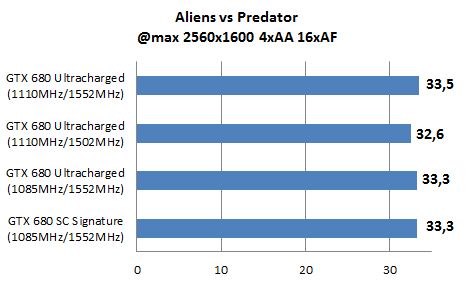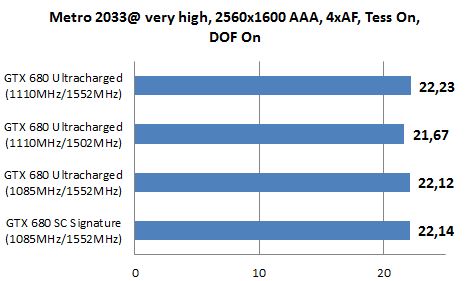It's a well known fact that the most popular graphics cards series usually had a few models that stood out and our today’s guest is Point of View/TGT’s GTX 680 Ultra Charged. The card comes with a hefty GPU overclock and proprietary design featuring both an improved power supply and triple fan cooling.
Geforce GTX 680 cards are based on GK104 graphics chip that is part of Nvidia’s Kepler architecture. Reference clocks for GTX 680 cards are at 1006MHz GPU, which is already quite high, but not maxed out. Thankfully, end users will benefit from this because now we see partners competing in who will make a meaner GTX 680. From what we’ve seen, running the GPU beyond 1100MHz would require better cooling than on the reference card. Of course, not all chips are made equal so it’s important to pick out the chips that can handle such clocks.
GTX 680 Ultra Charged comes with a 1110MHz GPU and it’s pretty much the maximum you can get with air cooling. Ultra Charged cards come with handpicked chips with low leakage and should enable for improved auto-overclocking with GPU Boost technology.

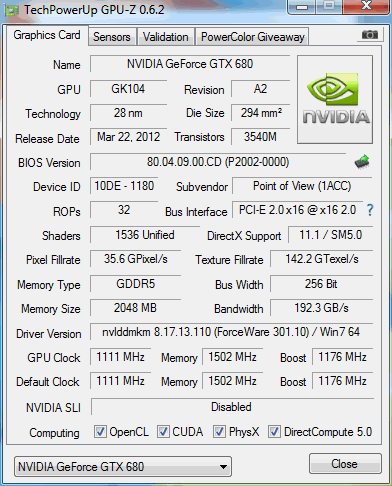
GTX 680 Ultracharged comes with no special extras – you get a driver CD and a user manual. The box is tough, with a design along the lines of PoV/TGT’s earlier designs.
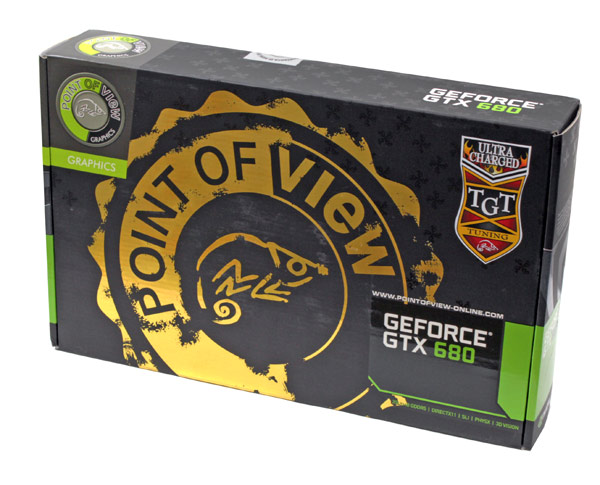


The cooler with three fans doesn’t only seem large – it actually is quite chunky and will take up three slots. We’ve already seen a few non –reference coolers for GTX 680 and they were wider than two slots, so we weren’t surprised by PoV/TGT’s move. The GPU comes overclocked by 104MHz and such feats require adequate cooling.

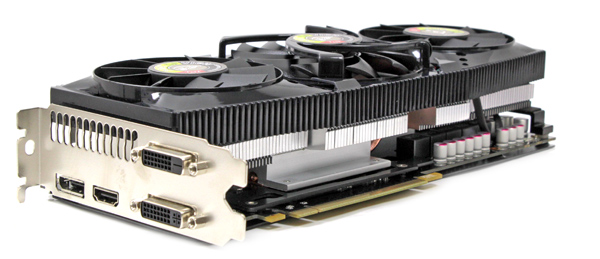
The following picture shows that the cooler is two slots wide with fans off.

The central fan is a 9cm one while the other two are 8cm. Size isn’t the only difference as the propellers were designed differently.

There are no signs or specs on the fans but we can confirm they do the job well. They only get loud beyond 65% RPM, but fan speed never exceeded 50% RPM, i.e. they were quiet.
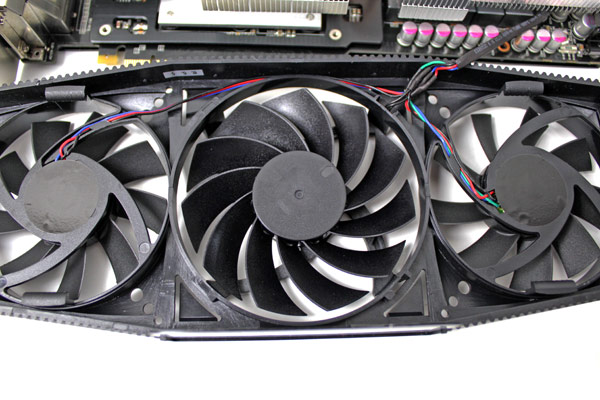
PoV/TGT probably could’ve used the metal plate above the central fan (picture below) for a logo or something, but it’s empty for now.

It seems to us that the plate is there simply to cover the spot where heatsink splits, see below.

The heatsink has five heatpipes – tree go towards the end and two towards the I/O panel.

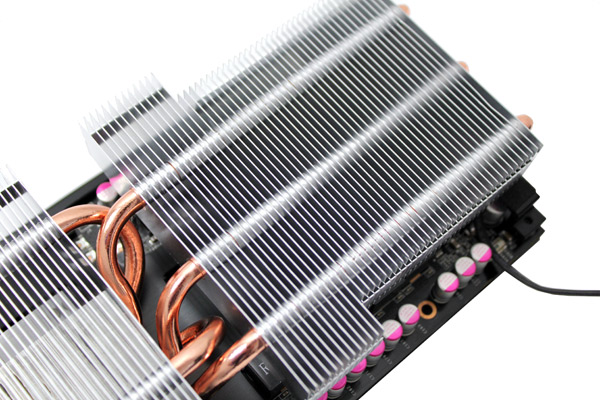
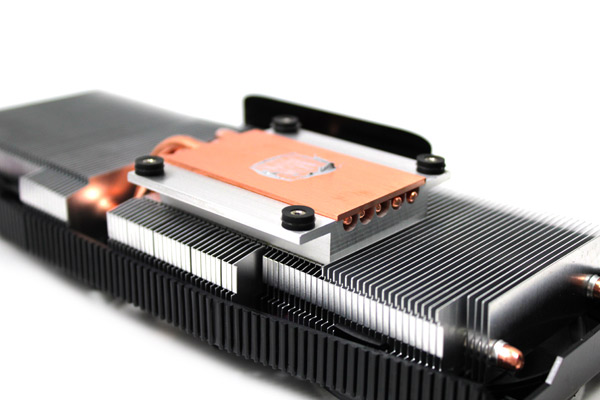
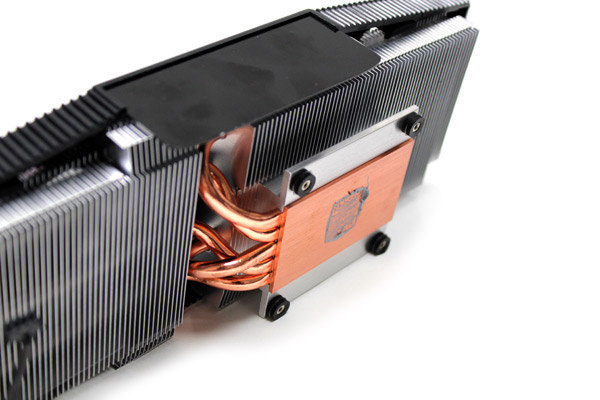
PoV/TGT strapped the card with a heatspreader for memory and other low profile components on the PCB.

GTX 680 Ultra Charged comes with 2GB of GDDR5 memory. The chips come from Hynix (model No: H5GQ2H24MFR-R0C) and are rated at 1500MHz (6000MHz GDDR5 effectively).
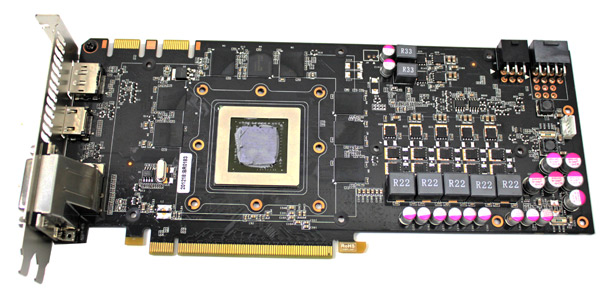

Reference GTX 680 cards draw power via two 6-pin connectors. Factory overclocked GTX 680 Ultra Charged has one 6-pin and one 8-pin power connector. Point of View / TGT uses five phase PWM design, one phase more than on the reference card.
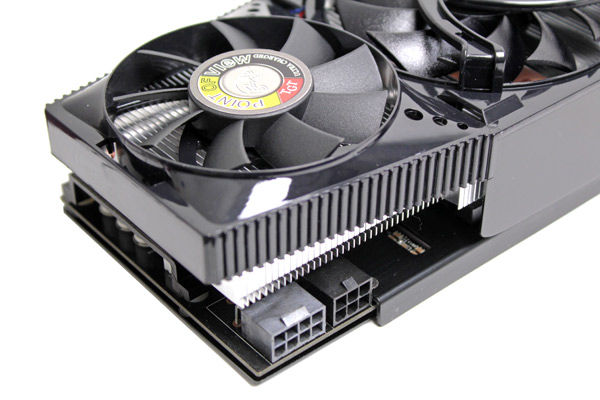
GTX 680 Ultracharged comes with two dual-link DVI outs, but only one is analog VGA-out capable. Strangely enough, PoV/TGT forgot to mention that VGA-out requires using the bottom DVI – the one in line with HDMI and DisplayPort connectors. Nvidia made sure not to lag behind the competition so Kepler based cards can run up to four displays simultaneously.
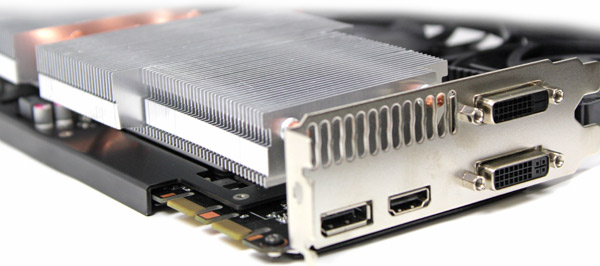
The card has two SLI connectors, which means Quad GPU is possible.
A metal plate was mounted on the back of the card. We must admit that it really does make it look better.


Testbed:
Motherboard: EVGA X79 FTW
CPU: Sandy Bridge-E Core i7 3820 (3.6GHz)
CPU Cooler: Thermalright HR-02 (Thermalright-Europa Distri www.PC-Cooling.de).
Memory: 8GB ADATA DDR3 1600 XPG Gaming series
Harddisk: OCZ Vertex 2 100 GB
Power Supply: CoolerMaster Silent Pro 1000W
Case: CoolerMaster Cosmos II Ultra Tower
Operating System: Win7 64-bit
Nvidia 301.10-desktop-win7-winvista-64bit-english-whql
amd_radeon_hd_7800_8.95.5_win7-64
12-3_vista_win7_64_dd_ccc.exe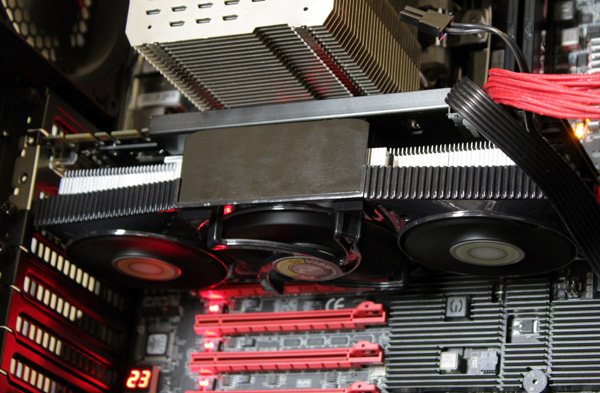
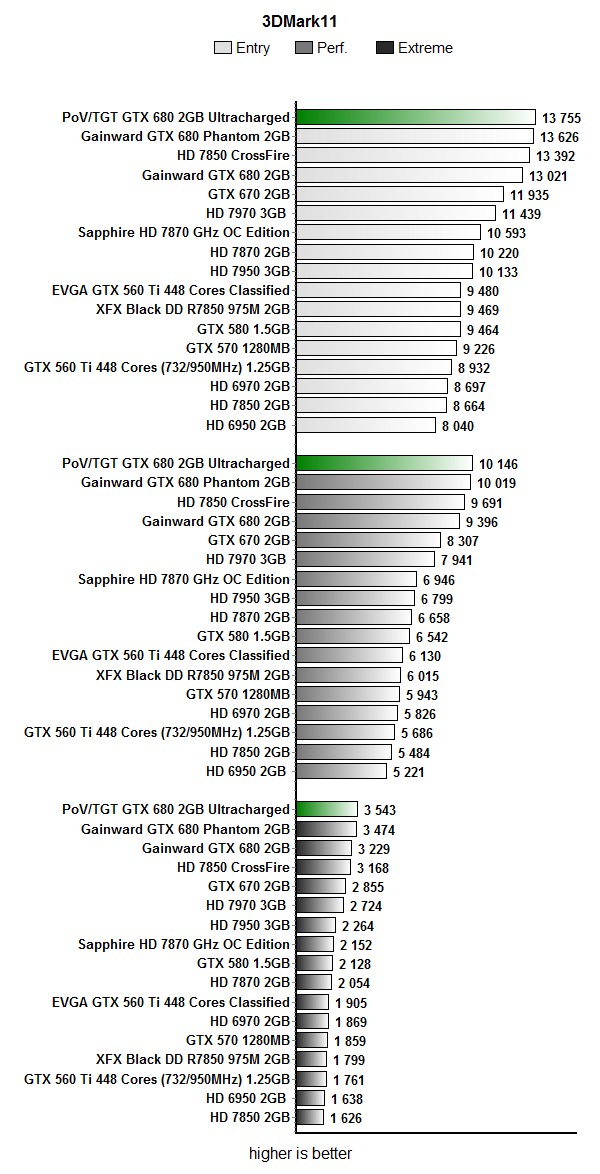

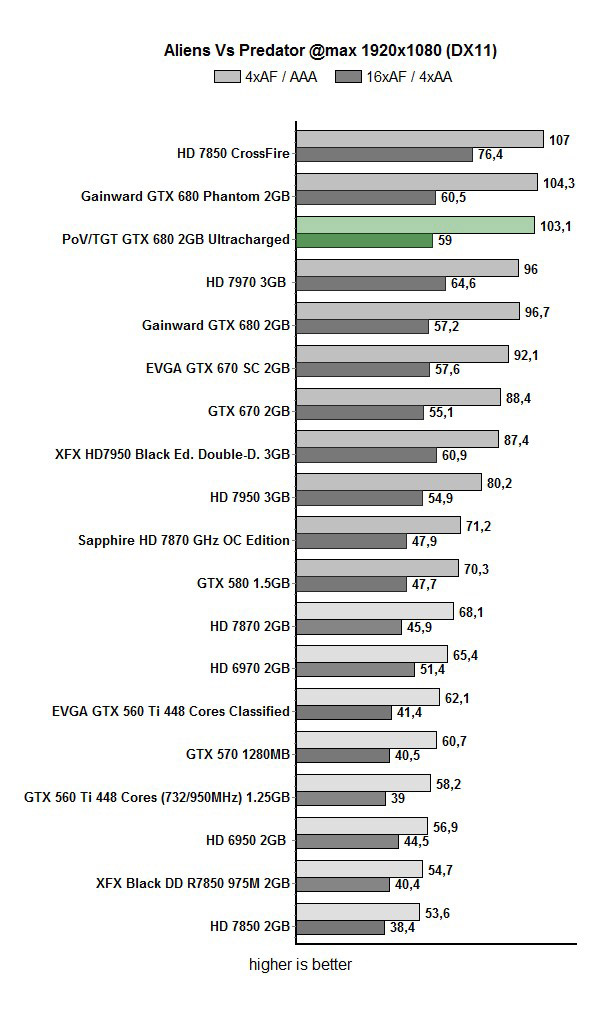
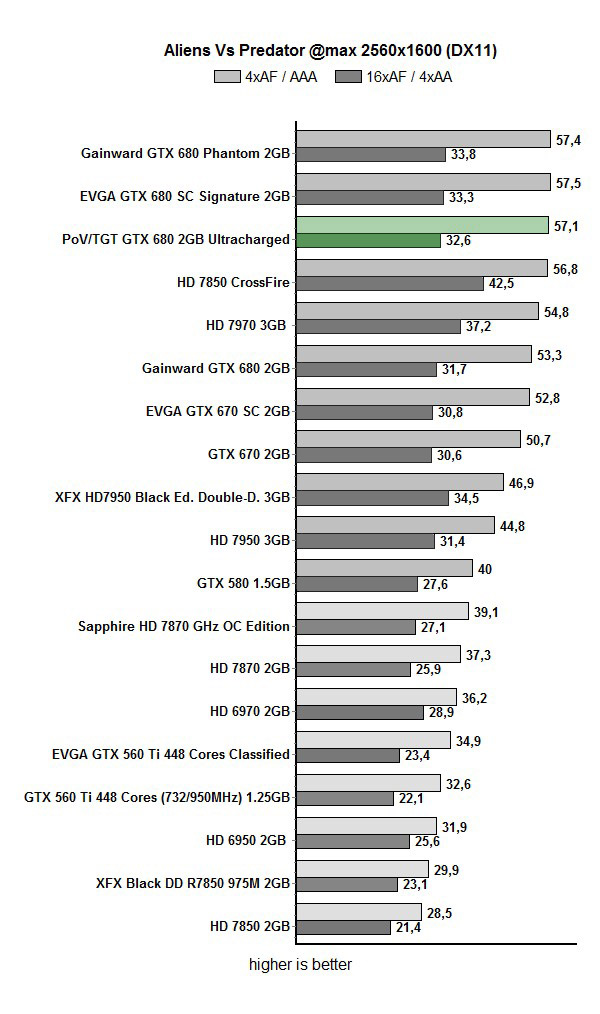
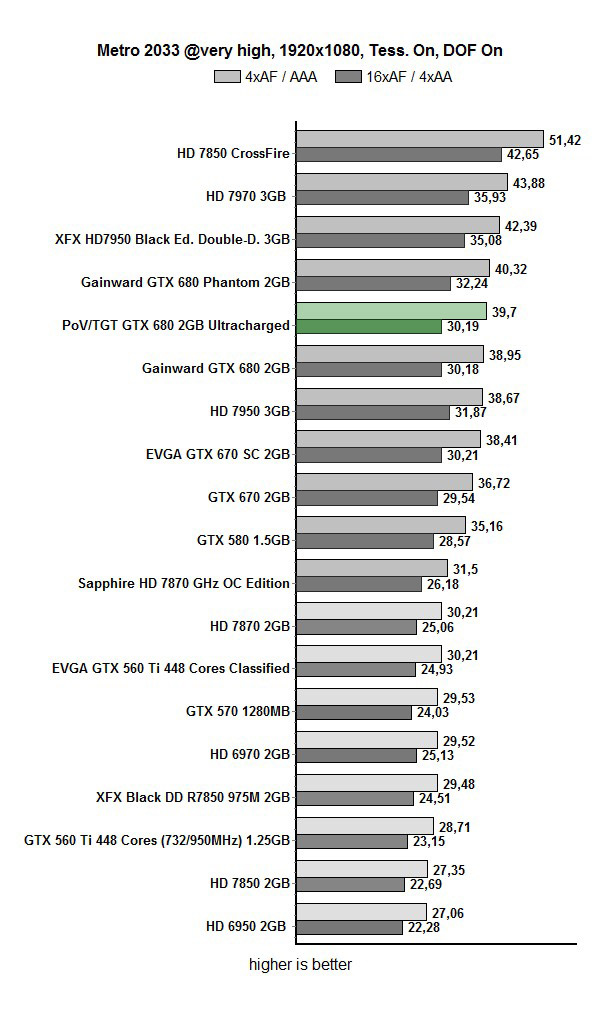
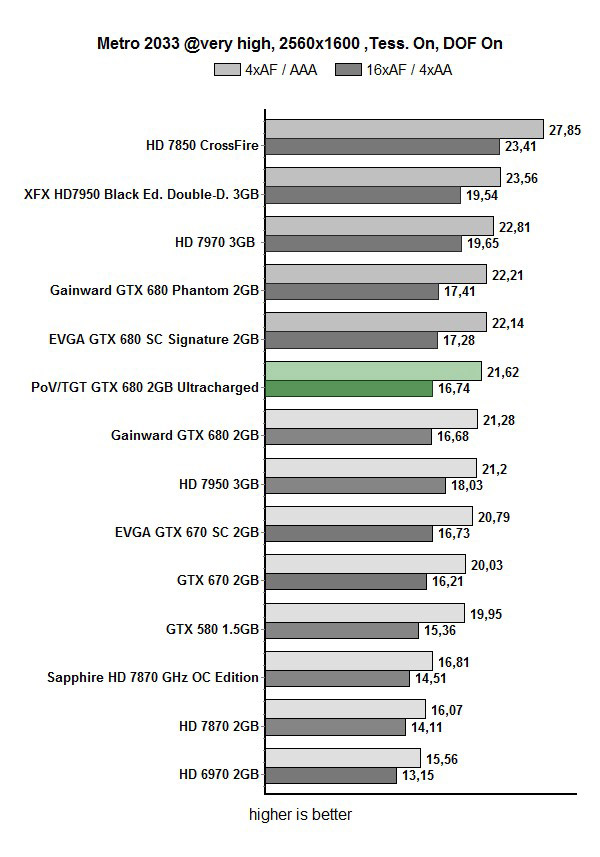

GPU Boost is an important factor in the entire GTX 600 series, since it controls how much and when to auto-overclock the GPU. Below you’ll find GPU clocks we got playing Metro 2033 at 2560x1600. Base clock is the guaranteed clock while Boost and all other clocks depend on whether the GPU is working too hard, whether thermals are fine and whether consumption is optimal. GPU Boost is good because the chip is used to the max and users don’t have to mess with overclocking since the card is already doing it itself.
TGT handpicked only the best chips with low leakage, which should result in top auto-overclocking results. Thermals are also important and GTX 680 Ultra Charged’s cooler keeps GPU temperatures below 70°C – as much as 10°C lower than on the reference GTX 680.
GTX 680 Ultra Charged’s Base clock is 1110MHz, Boost is 1176 MHz. As you can see, clocks are up to 1228MHz. It appears as if TGT managed to nail GPU Boost to the highest possible auto-OC clock.
The following graph shows GPU clocks on another GTX 680, whose GPU Boost clocks change more often. Such a card is representative of pretty much all the GTX 680s we’ve tested.
We measured one of the results in the table by downclocking Ultra Charged’s GPU and overlocking the memory, so as to match the GTX 680 Signature.
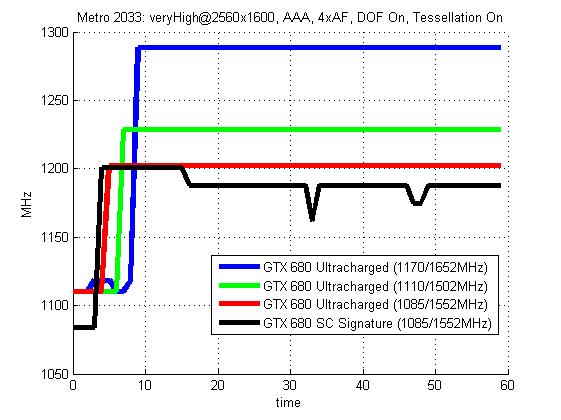
Pov/TGT chose not to overclock GTX Ultra Charged’s memory. The reason is that the overclock would not have resulted in a significant performance increase. The GTX 680 has plenty of bandwidth so faster memory would only boost consumption. Although Crysis 2 suggested that this is indeed the case, AvP and Metro 2033 sti benefited from the memory overclock.
Most factory overclocked GTX 680 cards come with memory at about 1550MHz. We used EVGA’s GTX 680 SC Signature as our reference. In the tables below, you can see how results woul've looked had TGT overclocked the memory as well.
AvP scored 2.7 percent batter after the memory overclock, while Metro 2033 sped up by 2.6 percent. Looking at the results, it’s clear that overclocking the memory does affect results. While we’d rather have overclocked memory on GTX 680 Ultra Charged cards, it’s not a problem since you can easily overclock it by a minimum of 100MHz.
GTX 680 Ultra Charged is factory overclocked and that GPU clock is 1110MH. Memory clock is reference, which means that the memory runs at 1502MHz (6008MHz effectively). We overclocked the memory by 150MHz and ran with it since it worked well. However, we focused more on GPU overclocking.
The photo below shows PrecisionX, which says that the Ultra Charged’s Power Target value is factory boosted.
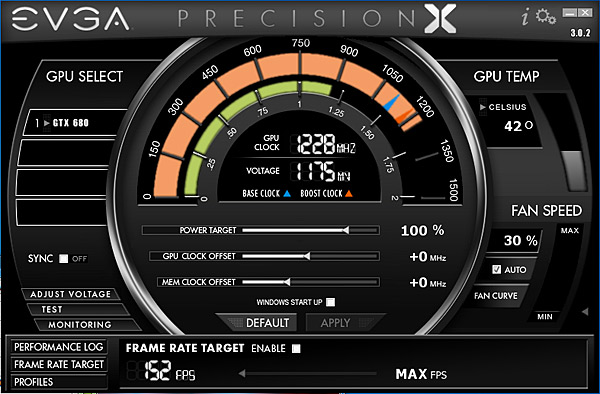
PowerTarget value can be additionally boosted by 12 percent. We could boost reference GTX 680 cards’ PowerTarget by 32 percent, which suggests that the Ultra Charged’s PowerTarget is factory set at 120 percent. Once the GPU is under load, voltage goes up to 1175mV, same like the reference GTX 680.
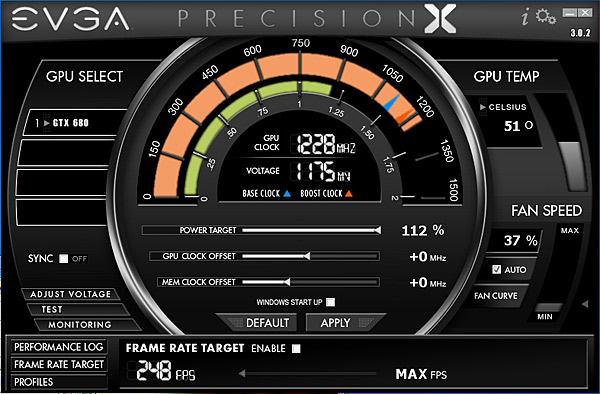
GTX 680 Ultra Charged’s cooler has three fans and runs great. Auto mode results in GPU temperatures up to 66°C. This is great considering that the GPU is up from reference 1006MHz to 1110MHz. Even better news is that the cooler is quiet when the card is under load as well. Note that reference cards run at about 80°C.

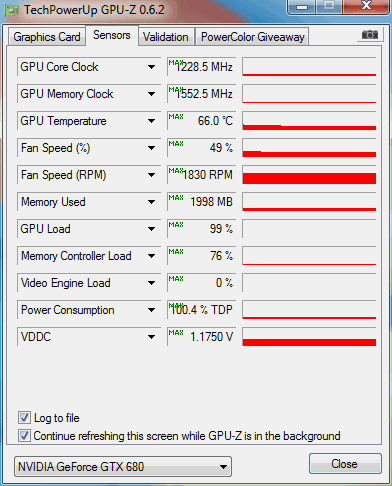

One can’t help but wonder about overclocking performance when the fans are sped up, especially since the cooler already runs great at 50 percent RPM. Unfortunately, increasing fan speed couldn’t help us get better overclocking results.
Running at 1180MHz, Unigine Heaven tended to crash at 100 percent RPM, but not when the fans are at 61 percent. We didn’t have enough time or adequate equipment to find the root of the problem. We thought that faster speed negatively affects cooling of PCB components or that the fans simply draw too much power.
Thankfully, there’s no need to worry – auto fan speed won’t exceed 50 percent RPM and the fans are quiet. Maximum GPU Clock Offset is +70MHz, but after some time you’ll notice some artifacts. The GPU was stable and ran happily at about 1160MHz.
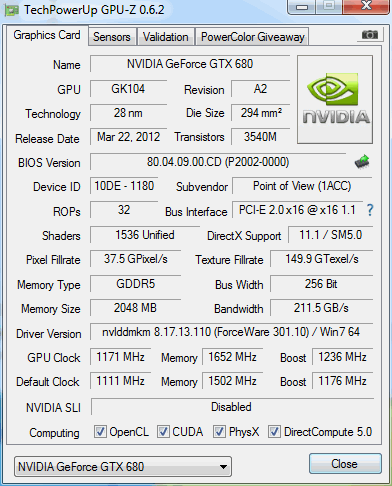
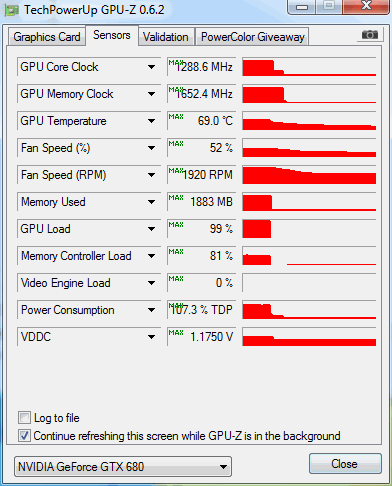

Consumption is not an issue since Nvidia did a good job designing its Kepler cards. Ultra Charged consumes about 20W more than the reference card, but the GPU runs 10 percent faster.

Point of View / TGT launched its first overclocked GTX 680 and called it Ultra Charged (model TGT-680-A1-2-UC). The card brings several improvements compared to the reference GTX 680. We’ll start with what may be the most important detail for most users – special triple-fan cooling. In idle mode, the cooler is almost inaudible and it remains quiet under load as well. The only downside would be the fact that it takes up three slots, but the silence is worth it. Most overclocked GTX 680 cards get loud when the GPU is working hard, but not GTX 680 Ultra Charged.
Another important thing that the Ultra Charged’s GPU runs at 1110MHz. Only a few GTX 680 cards boast GPU clock of over 1100MHz. In order to supply the card with enough power, TGT threw in a 6-pin and an 8-pin connectors and added another phase for the GPU.
GPU comes overclocked but the memory runs at reference clocks. Although the memory isn’t difficult to overclock, we’d still rather see TGT do it, because the card would outpace almost all the GTX 680s around.
GTX 680 Ultra Charged is currently listed some €90 higher than reference cards go for, here. This may be considered a bit steep and we believe that a price tag some €60 over the reference card sounds much more reasonable. If you’re looking for silent cooling, then this card is made for you. If you want an overclocked GTX 680, then again the answer is Ultra Charged. Furthermore, TGT made a sweet selection of chips, where only low leakage GPUs ended up on the Ultra Charged, where higher GPU boost clocks are a direct result.





